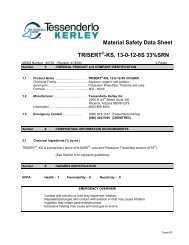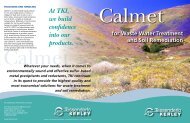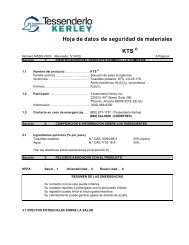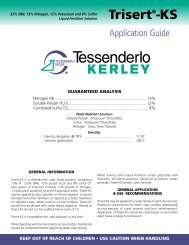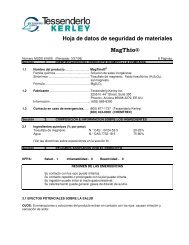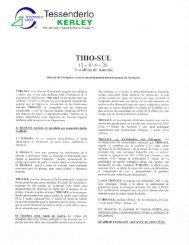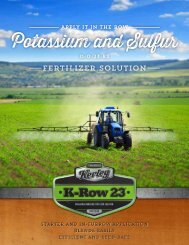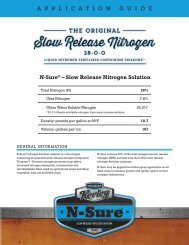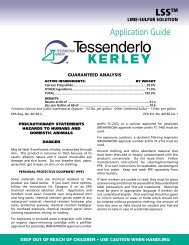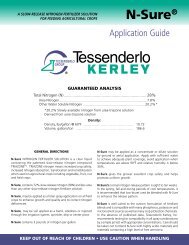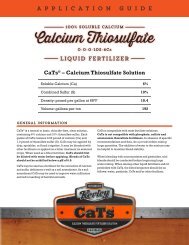Trisert-NB MSDS.pdf - Tessenderlo Kerley
Trisert-NB MSDS.pdf - Tessenderlo Kerley
Trisert-NB MSDS.pdf - Tessenderlo Kerley
You also want an ePaper? Increase the reach of your titles
YUMPU automatically turns print PDFs into web optimized ePapers that Google loves.
Material Safety Data Sheet<br />
TRISERT ® -<strong>NB</strong>, 26-0-0<br />
<strong>MSDS</strong> Number 43400 (Revised: 5/6/02)<br />
Section 1: CHEMICAL PRODUCT and COMPANY IDENTIFICATION<br />
6 Pages<br />
1.1 Product Name ...................................... <strong>Trisert</strong> ® -<strong>NB</strong> foliar fertilizer solution<br />
Chemical Family .................................... Aqueous, organic salt solution<br />
Synonyms .............................................. Potassium sulfate, Triazone and urea<br />
Formula .................................................. N/A - blend<br />
1.2 Manufacturer ........................................ <strong>Tessenderlo</strong> <strong>Kerley</strong> Inc.<br />
2255 N. 44 th Street, Suite 300<br />
Phoenix, Arizona 85008-3279<br />
Information ..........................…............... (602) 889-8300<br />
1.3 Emergency Contact ...................... (800) 877-1737 (<strong>Tessenderlo</strong> <strong>Kerley</strong>)<br />
(800) 424-9300 (CHEMTREC)<br />
Section 2: COMPOSITION, INFORMATION ON INGREDIENTS<br />
2.1 Chemical Ingredients (% by wt.)<br />
TRISERT® -<strong>NB</strong> is a proprietary blend of urea and Potassium sulfate and Triazone.<br />
(See Section 8 for exposure guidelines)<br />
Section 3: HAZARDS IDENTIFICATION<br />
NFPA: Health - 1 Flammability - 0 Reactivity - 0<br />
EMERGENCY OVERVIEW<br />
Contact with solution or mist may cause eye irritation.<br />
Repeated/prolonged skin contact with solution or mist may cause irritation.<br />
Ingestion may irritate gastrointestinal tract.<br />
Excessive heating may cause ammonia gas to evolve.<br />
<strong>Trisert</strong>-<strong>NB</strong>
Page 2.<br />
Section 3: HAZARDS IDENTIFICATION (Cont.)<br />
3.1 POTENTIAL HEALTH EFFECTS<br />
EYE: Contact with the eyes by product mist or solution may cause irritation or a burning sensation.<br />
SKIN CONTACT: Prolonged or repeated contact with product mist or solution may cause skin irritation.<br />
SKIN ABSORPTION: Absorption is unlikely to occur.<br />
INGESTION: Ingestion of product solution may cause irritation of the gastrointestinal tract to include nausea,<br />
vomiting and diarrhea. These blends are considered to have a low toxicity to humans.<br />
INHALATION: Inhalation of product mist may cause irritation of the nose, throat and respiratory tract.<br />
CHRONIC EFFECTS/CARCINOGENICITY:<br />
Not listed as a carcinogen by NTP, IARC or OSHA.<br />
Section 4: FIRST AID MEASURES<br />
4.1 EYES: Immediately flush with large quantities of water for 15 minutes. Hold eyelids apart during irrigation<br />
to insure thorough flushing of the entire area of the eye and lids. Obtain medical attention.<br />
4.2 SKIN: Immediately flush with large quantities of water. Remove contaminated clothing under a safety<br />
shower. Obtain medical attention if irritation occurs.<br />
4.3 INGESTION: If victim is conscious, give 2 to 4 glasses of water and induce vomiting by touching finger to<br />
back of throat. Obtain medical attention.<br />
4.4 INHALATION: Remove victim from contaminated atmosphere. If breathing is labored, administer oxygen.<br />
If breathing has ceased, clear airway and start mouth to mouth resuscitation. If heart has stopped beating,<br />
external heart massage should be applied. Obtain medical attention.<br />
Section 5: FIRE FIGHTING MEASURES<br />
5.1 FLAMMABLE PROPERTIES<br />
FLASH POINT: Not flammable<br />
METHOD USED: NA<br />
5.2 FLAMMABLE LIMITS LFL: NA UFL: NA<br />
5.3 EXTINGUISHING MEDIA: As appropriate for combustibles involved in fire.<br />
5.4 FIRE & EXPLOSIVE HAZARDS: Heating to dryness may cause the release of ammonia and carbon<br />
dioxide. This ammonia, NH 3, may form flammable mixtures (16-25%) with air.<br />
Keep containers/storage vessels in fire area cooled with water spray. Intense heating may cause the release<br />
of ammonia vapors.<br />
<strong>Trisert</strong>-<strong>NB</strong>
Page 3<br />
Section 5: FIRE FIGHTING MEASURES (Cont.)<br />
5.5 FIRE FIGHTING EQUIPMENT: As in any fire, wear self-contained breathing apparatus, pressure<br />
demand, MSHA/NIOSH (approved or equivalent) and full protective gear.<br />
Section 6: ACCIDENTAL RELEASE MEASURES<br />
6.1 Small releases: Confine and absorb small releases on sand earth or other inert absorbent. Use water<br />
spray to dilute to weak fertilizer solution.<br />
6.2 Large releases: Confine area to qualified personnel. Shut off release if safe to do so. Dike spill area to<br />
prevent runoff into sewers, drains or surface waterways (potential aquatic toxicity). Recover as much of the<br />
solution as possible. Treat remaining material as a small release (above).<br />
Section 7: HANDLING and STORAGE<br />
7.1 Handling: Avoid contact with eyes. Use only in a well ventilated area. Wash thoroughly after handling.<br />
Avoid prolonged or repeated breathing of vapors. Avoid prolonged or repeated contact with the skin.<br />
7.2 Storage: Store in well ventilated areas. Do not store combustibles in the area of storage vessels. Keep<br />
away from any sources of heat or flame. Store tote and smaller containers out of direct sunlight at moderate<br />
temperatures [less than 105ºF (41ºC)]. (See Section 10.4 for materials of construction)<br />
Section 8: EXPOSURE CONTROLS, PERSONAL PROTECTION<br />
8.1 RESPIRATORY PROTECTION: None generally required. If conditions exist where mist may be<br />
generated, a NIOSH/MSHA approved mist respirator should be worn.<br />
8.2 SKIN PROTECTION: Neoprene rubber gloves and apron should be worn to prevent repeated or<br />
prolonged contact with the liquid. Wash contaminated clothing prior to reuse.<br />
8.3 EYE PROTECTION: Chemical goggles and a full face shield<br />
8.4 EXPOSURE GUIDELINES:<br />
OSHA<br />
ACGIH<br />
TWA STEL TLV STEL<br />
None N/A NA NA NA<br />
8.5 ENGINEERING CONTROLS: Use adequate exhaust ventilation to prevent inhalation of product vapors.<br />
<strong>Trisert</strong>-<strong>NB</strong>
Page 4.<br />
Section 9: PHYSICAL and CHEMICAL PROPERTIES<br />
9.1 APPEARANCE: Clear, green liquid<br />
9.2 ODOR: May have a slight amine odor<br />
9.3 BOILING POINT: 235ºF<br />
9.4 VAPOR PRESSURE: Not Determined<br />
9.5 VAPOR DENSITY: Not determined<br />
9.6 SOLUBILITY IN WATER: Complete<br />
9.7 SPECIFIC GRAVITY: 1.21 (10.08 lbs/gal)<br />
9.8 MELTING POINT: Salt out temperature less than 0º F (-18ºC)<br />
9.9 pH: Typically 8.5<br />
9.10 VOLATILE: Not applicable<br />
Section 10: STABILITY and REACTIVITY<br />
10.1 STABILITY: This is a stable material<br />
10.2 HAZARDOUS POLYMERIZATION: Will not occur<br />
10.3 HAZARDOUS DECOMPOSITION PRODUCTS: Heating to dryness will cause the production of<br />
ammonia, and oxides of carbon. This ammonia may form flammable mixtures (16-25%) with air.<br />
10.4 INCOMPATIBILITY: Strong oxidizers such as nitrates, nitrites or chlorates can cause explosive mixtures<br />
if heated to dryness. Avoid contact with Acids or acid materials. This product may not be compatible with<br />
copper, zinc or their alloys (i.e. bronze, brass, galvanized metals, etc.). These materials of construction<br />
should not be used in piping, handling systems or storage containers for this product. (SEE Section 7.2,<br />
Storage)<br />
Section 11: TOXICOLOGICAL INFORMATION<br />
11.1 ORAL: Data not available<br />
11.2 DERMAL: Data not available<br />
11.3 INHALATION: Data not available<br />
11.4 CHRONIC/CARCINOGENICITY: No evidence available<br />
11.5 TERATOLOGY: Data not available<br />
11.6 REPRODUCTION: Data not available<br />
11.7 MUTAGENICITY: Data not available<br />
<strong>Trisert</strong>-<strong>NB</strong>
Page 5<br />
Section 12: ECOLOGICAL INFORMATION<br />
No data available.<br />
Section 13: DISPOSAL CONSIDERATIONS<br />
The product TRISERT®-<strong>NB</strong> is not considered hazardous waste under Federal Hazardous Waste Regulations,<br />
40 CFR 261. Consult state and local regulations for more restrictive disposal regulations.<br />
Section 14: TRANSPORT INFORMATION<br />
14.1 DOT Shipping Name: Potassium sulfate, triazone and urea fertilizer solution<br />
14.2 DOT Hazard Class: NA<br />
14.3 UN/NA Number: NA<br />
14.4 Packing Group: NA<br />
14.5 DOT Placard: NA<br />
14.6 DOT Label(s): NA<br />
14.7 IMO Shipping Name: Potassium sulfate, triazone and urea fertilizer solution<br />
14.8 RQ (Reportable Quantity): NA<br />
14.9 RR STCC Number: Unknown<br />
Section 15: REGULATORY INFORMATION<br />
15.1 OSHA: This product is listed as a hazardous material under criteria of the Federal<br />
OSHA Hazard Communication Standard, 29 CFR 1910.1200.<br />
15.2 SARA TITLE III: a. EHS (Extremely Hazardous Substance) List: No<br />
b. Section 311/312, (Tier I,II) Categories: Immediate (acute) Yes<br />
Fire<br />
No<br />
Sudden release No<br />
Reactivity<br />
No<br />
Delayed (chronic) No<br />
c. Section 313 (Toxic Release Reporting-Form R): No<br />
Chemical Name CAS Number<br />
NA<br />
Concentration<br />
<strong>Trisert</strong>-<strong>NB</strong>
Page 6<br />
Section 15: REGULATORY INFORMATION (Cont.)<br />
d. TPQ (Threshold Planning Quantity): No<br />
15.3 CERCLA/SUPERFUND: RQ (Reportable Quantity) No<br />
15.4 TSCA (Toxic Substance Control Act) Inventory List: Yes<br />
15.5 RCRA (Resource Conservation and Recovery Act) Status: NA<br />
15.6 WHMIS (Canada) Hazard Classification: NA<br />
15.7 DOT Hazardous Material: (See Section 14) No<br />
15.8 CAA Hazardous Air Pollutant (HAP) No<br />
Section 16: OTHER INFORMATION<br />
REVISIONS:<br />
The entire <strong>MSDS</strong> was reformatted to comply to ANSI Standard Z400.1-<br />
1993, by Technical Services-<strong>Tessenderlo</strong> <strong>Kerley</strong>, Inc.<br />
Address updated, 5/3/99<br />
Revised Section 8.3, Eye Protection, and company logo, 5/6/02<br />
THE INFORMATION PUBLISHED IN THIS MATERIAL SAFETY DATA SHEET HAS BEEN COMPILED FROM OUR EXPERIENCE<br />
AND OSHA, ANSI, NFPA, DOT, ERG, AND CHRIS. IT IS THE USER’S RESPONSIBILITY TO DETERMINE THE SUITABILITY OF<br />
THIS INFORMATION FOR THE ADOPTION OF NECESSARY SAFETY PRECAUTIONS. WE RESERVE THE RIGHT TO REVISE<br />
MATERIAL SAFETY DATA SHEETS PERIODICALLY AS NEW INFORMATION BECOMES AVAILABLE.<br />
<strong>Trisert</strong>-<strong>NB</strong>



